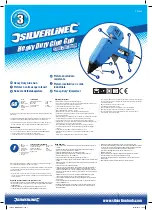
9 ENGLISH
It is an employer's responsibility to enforce
the use of appropriate safety protective equip-
ments by the tool operators and by other per-
sons in the immediate working area.
5.
The risks to others shall be assessed by the
operator.
6.
Be careful with tools without workpiece con-
tact as they can be fired unintentionally and
injure operator and/or bystander.
7.
Ensure tool is always safely engaged on the
workpiece and cannot slip.
8.
Wear hearing protection to protect your ears
against exhaust noise and head protection.
Also wear light but not loose clothing. Sleeves
should be buttoned or rolled up. No necktie
should be worn.
Operating hazards
1.
Hold the tool correctly: be ready to counteract
normal or sudden movements such as recoil.
2.
Maintain a balanced body position and secure
footing.
3.
Appropriate safety glasses shall be used and
appropriate gloves and protective clothing are
recommended.
4.
Appropriate hearing protection shall be worn.
5.
Use the correct energy supply as directed in
the instruction manual.
6.
Do not use the tool on moving platforms or
back of trucks.
Sudden movement of the platform
may lose control of the tool and cause injury.
7.
Always assume that the tool contains fasteners.
8.
Do not rush the job or force the tool. Handle
the tool carefully.
9.
Watch your footing and maintain your balance
with the tool.
Make sure there is no one below when
working in high locations, and secure the air hose to
prevent danger if there is sudden jerking or catching.
10.
On rooftops and other high locations, drive
fasteners as you move forward.
It is easy to lose
your footing if you drive fasteners while inching
backward. When driving fasteners against perpen-
dicular surface, work from the top to the bottom.
You can perform driving operations with less
fatigue by doing so.
11.
A fastener will be bent or the tool can become
jammed if you mistakenly drive fastener on
top of another fastener or strike a knot in the
wood. The fastener may be thrown and hit
someone, or the tool itself can react danger-
ously. Place the fasteners with care.
12.
Do not leave the loaded tool or the air com-
pressor under pressure for a long time out in
the sun. Be sure that dust, sand, chips and
foreign matter will not enter the tool in the
place where you leave it setting.
13.
Never attempt to drive fasteners from both the
inside and outside at the same time.
Fasteners may
rip through and/or fly off, presenting a grave danger.
Repetitive motions hazards
1.
When using a tool for long periods, the operator
may experience discomfort in the hands, arms,
shoulders, neck, or other parts of the body.
2.
While using a tool, the operator should adopt
a suitable but ergonomic posture. Maintain
secure footing and avoid awkward or off-bal-
anced postures.
3.
If the operator experiences symptoms such as
persistent or recurring discomfort, pain, throb-
bing, aching, tingling, numbness, burning sen-
sation, or stiffness, do not ignore these warning
signs. The operator should consult a qualified
health professional regarding overall activities.
4.
The continuous use of the tool may cause
repetitive strain injury due to recoil produced
by the tool.
5.
To avoid repetitive strain injury, the operator
should not overreach or use excessive force.
Additionally, the operator should take a rest
when feeling fatigue.
6.
Conduct a risk assessment regarding repetitive
motion hazards. It should focus on muscu-
lar-skeletal disorders and be preferentially
based on the assumption that decreasing fatigue
during work is effective in reducing disorders.
Accessory and consumable hazards
1.
Disconnect the energy supply to the tool, such
as air or gas or battery as applicable, before
changing/replacing accessories such as work-
piece contact, or making any adjustments.
2.
Use only the sizes and types of accessories
that are provided by the manufacturer.
3.
Use only lubricants recommended in this manual.
Workplace hazards
1.
Slips, trips and falls are major causes of work-
place injury. Be aware of slippery surfaces
caused by use of the tool and also of trip haz-
ards caused by the air line hose.
2.
Proceed with additional care in unfamiliar
surroundings. Hidden hazards may exist, such
as electricity or other utility lines.
3.
This tool is not intended for use in potentially
explosive atmospheres and is not insulated
from coming into contact with electric power.
4.
Make sure there are no electrical cables, gas
pipes etc. that could cause a hazard if dam-
aged by use of the tool.
5.
Keep work area clean and well lit.
Cluttered or
dark areas invite accidents.
6.
There may be local regulations concerning
noise which must be complied with by keeping
noise levels within prescribed limits. In certain
cases, shutters should be used to contain
noise.
Summary of Contents for AN635H
Page 2: ...1 2 3 4 5 Fig 1 Fig 2 1 Fig 3 1 Fig 4 1 2 3 Fig 5 1 Fig 6 1 2 3 Fig 7 1 Fig 8 2 ...
Page 3: ...1 2 3 4 Fig 9 1 Fig 10 1 2 3 Fig 11 Fig 12 1 3 2 Fig 13 1 2 Fig 14 1 2 Fig 15 1 2 Fig 16 3 ...
Page 4: ...1 Fig 17 1 2 3 Fig 18 1 2 Fig 19 1 1 2 2 Fig 20 2 1 Fig 21 1 2 Fig 22 A C B Fig 23 4 ...
Page 5: ...B A C Fig 24 1 Fig 25 1 2 3 Fig 26 Fig 27 1 Fig 28 1 Fig 29 1 Fig 30 1 Fig 31 5 ...
Page 6: ...1 2 Fig 32 6 ...
Page 103: ...103 ...

































